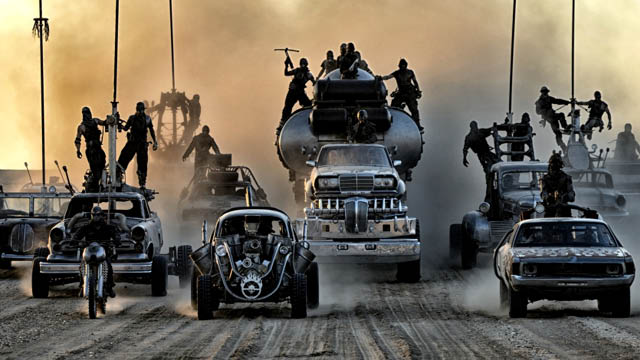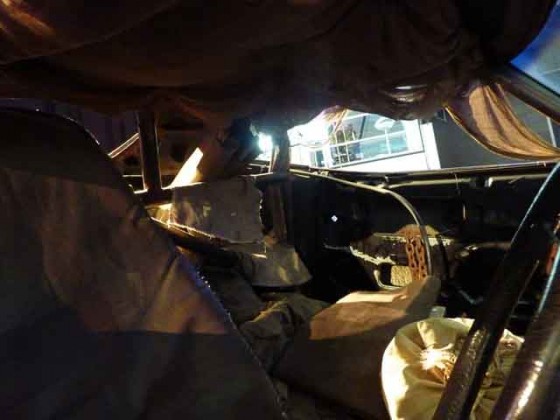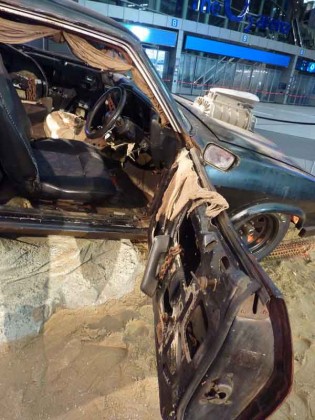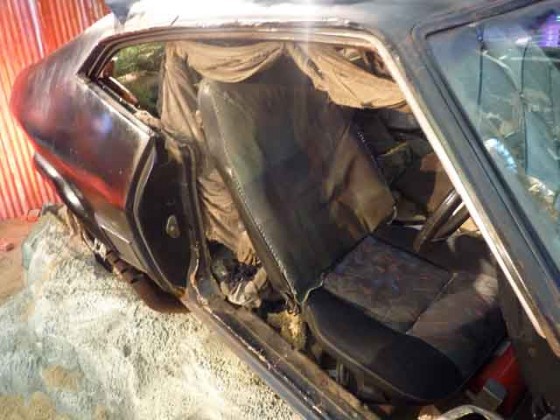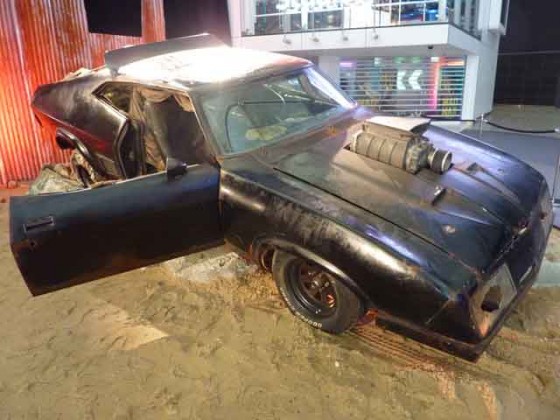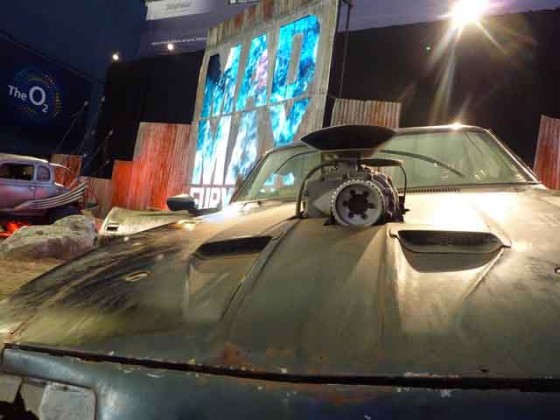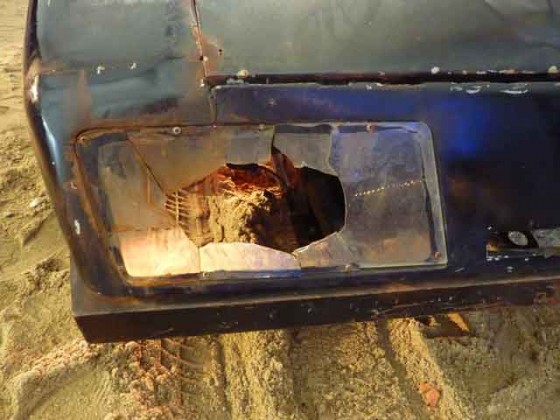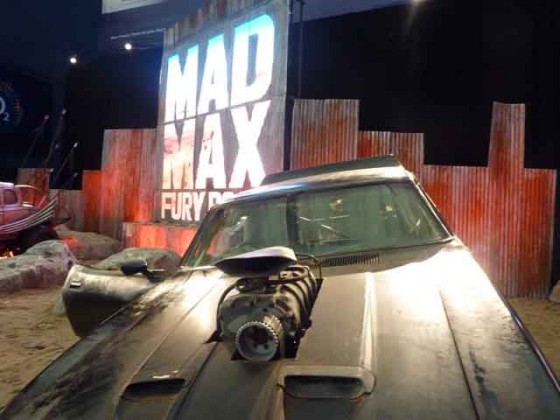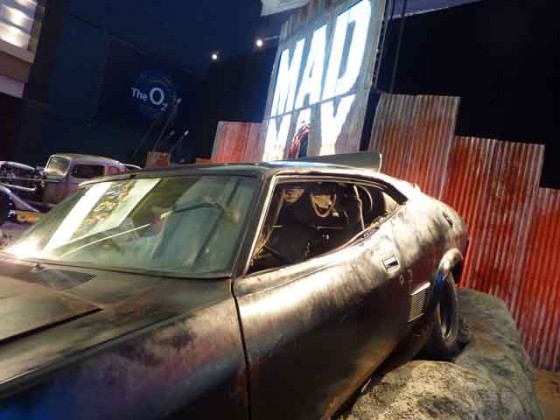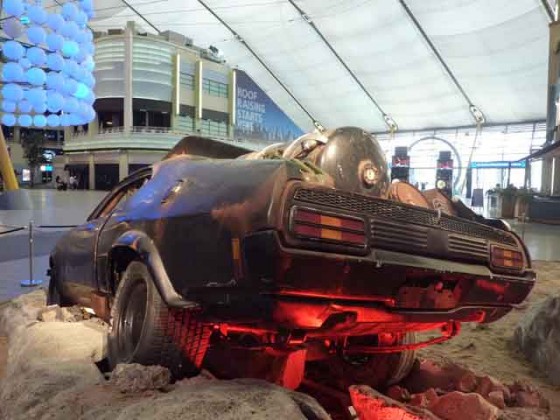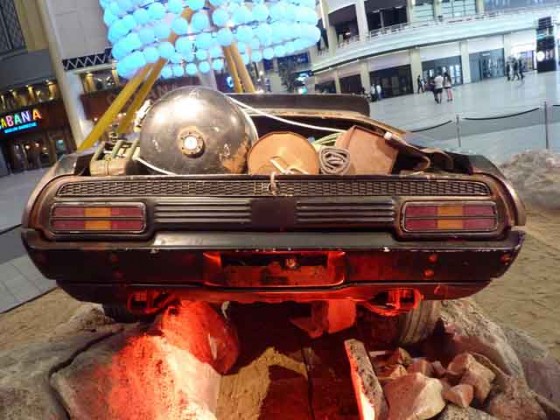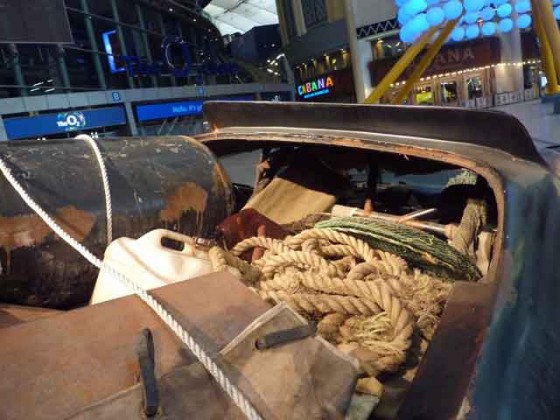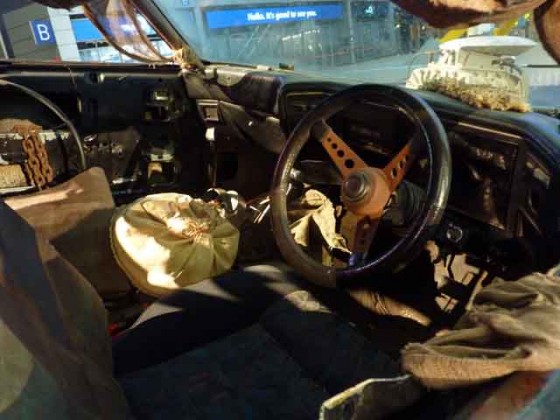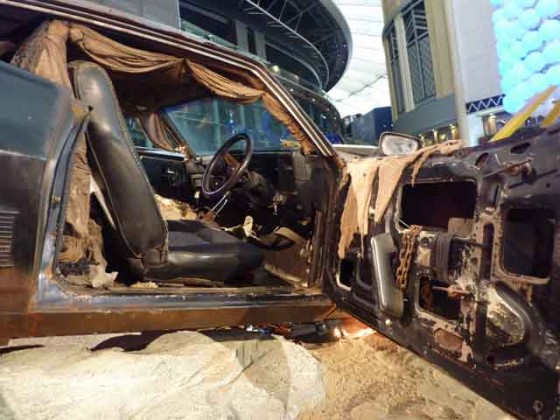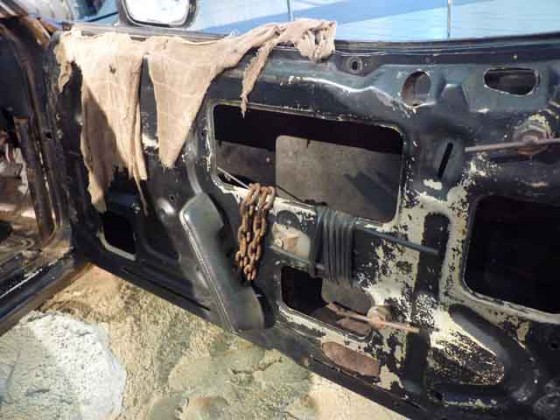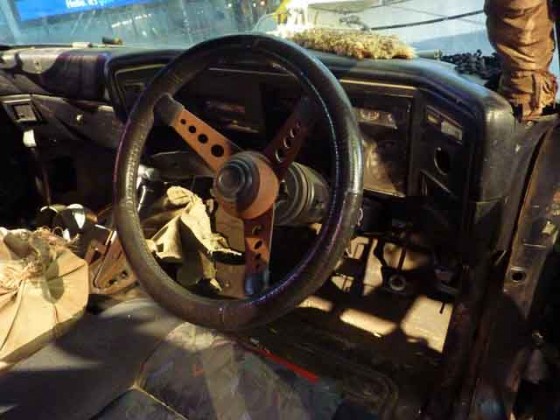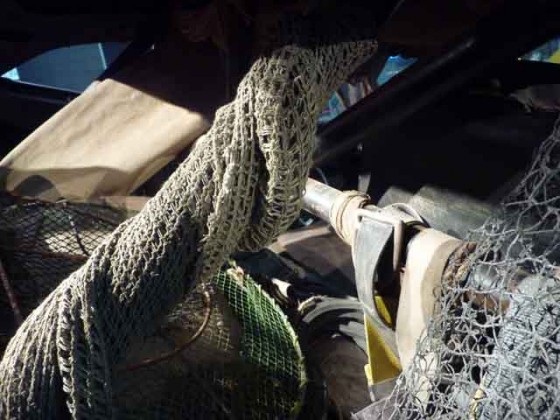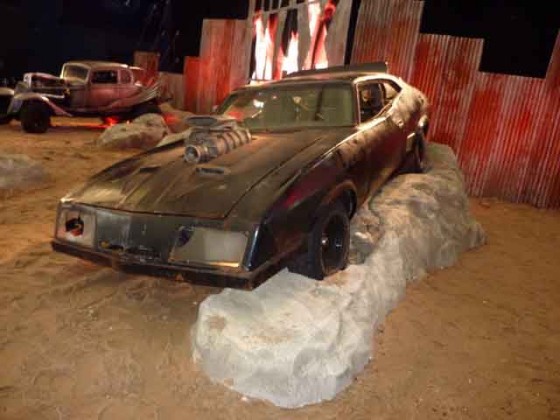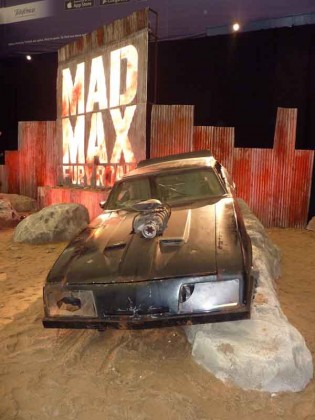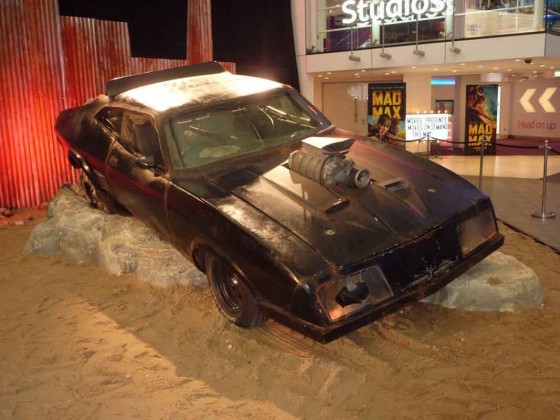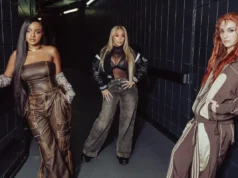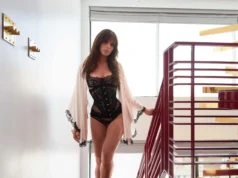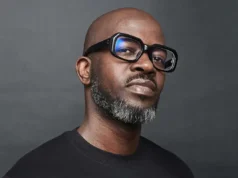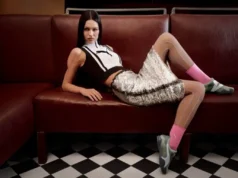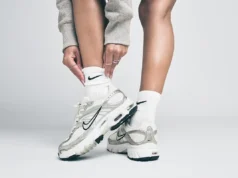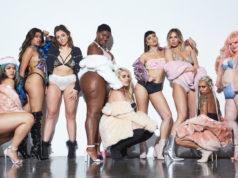Following on from our special feature on The Cars of Fast & Furious 7, we are delighted to bring you this exclusive look at The Cars of Mad Max Fury Road, which is unleashed in cinemas 14th May 2015.
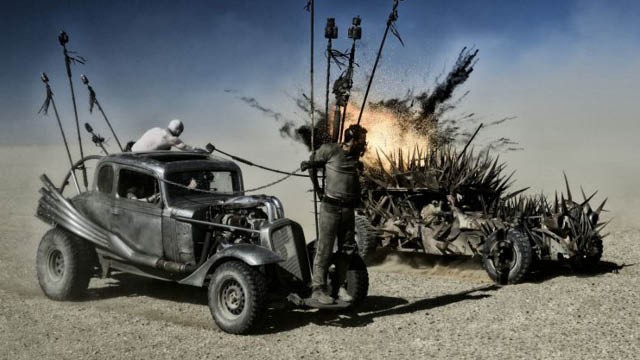
Today we popped over to The o2 (Greenwich, London) to see a special showcase of The Cars of Mad Max Fury Road. Much to our delight we were the first in attendance, yes the early bird really does catch the worm and we had a chance to sit in both the cars that Tom Hardy (Mad Max) and Nicholas Hoult (Nux) who we have an exclusive Mad Mad Fury Road interview with drive in the film.
Between the 11 -14 May, Warner Bros. Entertainment UK are giving visitors the chance to come and see the cars driven by Tom Hardy and Nicholas Hoult in George Miller’s post-apocalyptic epic MAD MAX: FURY ROAD. Not only can visitors immerse themselves in the world of Mad Max via an exclusive green screen photo opportunity but they’ll be able to view and experience the cars in the Sky News Room in the exclusive Sky Studios.
So let’s take a look at the Interceptor, this is the car the Tom Hardy drives in the movie.
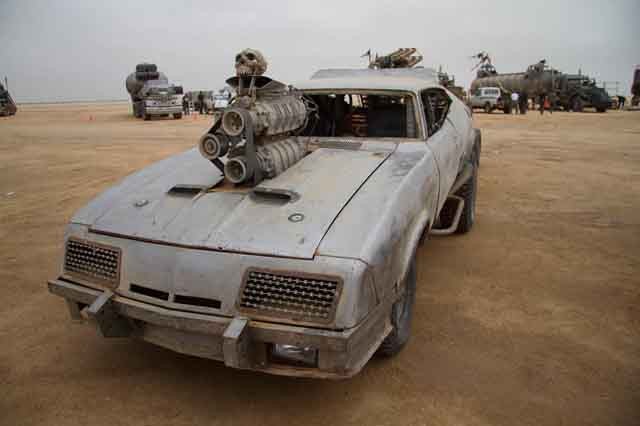
NAME: INTERCEPTOR
DRIVER: MAX ROCKATANSKY (TOM HARDY)
MODEL: XB FORD FALCON COUPE
ORIGIN: MFP PROTOTYPE
“In the Westerns, the cowboys had their favourite horse and Max has his Interceptor,” Miller observes. Hatched by Rev-Heads as a supercharged prototype during civilization’s last gasp, Max Rockatansky’s signature black Interceptor is now, like the man who drives it, a wounded survivor on the wastes, haunted and reshaped by Road Wars past. “It’s in just as bad shape as he is—it keeps getting destroyed and resurrected,” Miller adds. The Interceptor began life as a 1974 XB Ford Falcon Coupe, Australia’s variant of the Ford muscle car, which was modified with a Concorde front end, Scott SuperSlot Injector hat and belt-driven blower before blazing into legend in 1979’s Mad Max. Though the weathered but still sexy death machine meets its fiery end in 1981’s The Road Warrior, we meet it again in Mad Max: Fury Road, “A legend spotted in the gutter,” Gibson details, “rusted through and rattling with one too many repairs and far too few original parts.”
Pretty slick right? We couldn’t believe how authentic, these cars are, no luxury items included, so the celebrity superstars had to use the cars as is. Next up let’s take a look at the Nux Car, this is the car that Nicholas Hoult drives in the film.
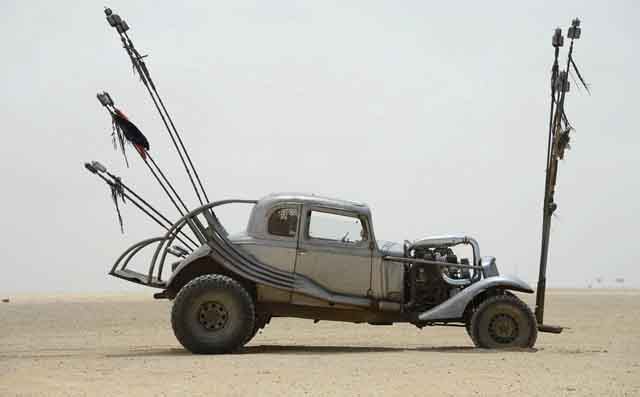
NAME: THE NUXCAR
DRIVER: NUX (NICHOLAS HOULT)
MODEL: CHEVROLET 5-DOOR COUPE
ORIGIN: THE CITADEL
As a gun driver and true believer in Immortan Joe’s army of Warboys, Nux venerates his Master with a skull and mask totem mounted to the hood of the Nuxcar that leads the way as he races toward battle glory in his quest to ride eternal with Immortan on the highways of Valhalla. “But his true god is the engine, his real church, the car,” Gibson notes. A super-turbocharged, nitrous-boosted, 5-window deuce coupe, Nux’s chariot is every hot rodder’s dream—a polished steel chassis fitted with a coiled V8 engine, canted wheels and swooping, wing-like exhaust pipes. Inside, the car’s interior is festooned with random toys and objects he’s found over the length of his short life, from his eyeball stick shift to his doll-face steering wheel. “There’s a joy in the insanity of it all,” Miller observes, “and Nux, being young, has the kind of joyous rambunctiousness of someone who grew up this world and knows nothing of what came before.”
If all of the above doesn’t impress you, then take a look at this special Q&A feature we have with Colin Gibson the (Production Designer) for Mad Max Fury Road.
On Mad Max: Fury Road, you were faced with the task of making vehicles that look cool but that are also sturdy enough to survive the rigors of filming in the Namibian desert. That has to create a ton of difficulties, marrying the machine to the role.
COLIN GIBSON: They had to perform, and, like any other character, had a part to play in fleshing out the story and making believable the world they inhabit. Technically, the desert terrain and climate made for logistic problems (overheating, wear on suspension, clogged aspirators, etc), but those very antagonisms added to the beauty and sheer physics of the action with swirling dust, spat sand and airborne vehicles. We design to the story and react to the reality, and each adds truth to the other. Further, we designed the design process to resemble as much as possible the HOW of the Warboys: scavenge, assemble, increase grunt, weaponize, increase grunt, add cup-holder, set off to war with v8 roar…
There’s a classiness to the muscle cars and some of the older models that makes them timeless, but also kind of harkens back to a time when you actually drove a car.
COLIN GIBSON: Well, that was part of the ethos. There’s the double helix of film design, one strand the requirements and logistics of the film-making, one the truth and logic of the story and the world we are in. Mad Max was set at the end of the ‘70s, and we wanted to use that as a starting point, yet now it’s far further into a future in freefall toward feudalism. So, why are we still using these cars? How do we justify this look? We have basically three fantastic reasons…
Number one, if you’re going to go to war you want heavy Detroit steel rather than carbon fiber. Number two: the analog/digital divide…You also want something you can fix yourself that has balls and grunt, but that is also mechanical, as opposed to computer chipped and plugged in. Number three, in a world of scarce resources and lost beauty, I can’t see anybody schlepping a Corolla halfway across the wasteland to save.
Tell us about the rolling nightmare called the People Eater? It looks like it’s got a Mercedes chassis to it.
COLIN GIBSON: Yeah. In [director] George [Miller]’s mind, the People Eater truck was always representative of the corporate industrial military complex. A horizontal cracking tower on wheels, refining fuels from oil even as it hurtled across the desert. The head of Gas Town is pretty much large, bald, and besuited—a bean counter who drives to kill and kills to acquire; he’s all about bartering fuel for water and munitions, so the story required his vehicle to be huge, corporate, military …and it was fated to explode in a massive climax. With the People Eater chassis, I was lucky enough that a wedding company closed down and their pair of old Mercedes stretch limos were up for sale, cheap. So, they became him. And then we did a little lattice cut-out instead of windows, as glass was rare and because he always struck me as Sydney Greenstreet in a Casablanca Café—a large, corpulent man counting coins in the back of a casbah.
There’s a Volkswagen Bug that we used for one of the Gas Town vehicles and we decided to make it the vehicle that tracked with him, like the fish that track with sharks to eat the parasites, the remora. (We were desperate to use a Volkswagen, and the lead Imperator of Gas Town has a domed bald head, is quite round and corpulent, so the Beetle became the perfect choice). It was beaten back to bare metal because it gave us the shiny, chrome dome; we aped the piping, drums, coils and condensation vats in shape and color to mimic the larger unit and viola, the beetle is reimagined, recycled and reborn.
Did you apply that same logic to each vehicle?
COLIN GIBSON: To each vehicle. We built close to 150 vehicles total but there were eighty-eight set characters.
The Mad Max Interceptor is very iconic in signature, but you’re not overly bound to expectations. Did you feel you had something of a blank canvas to adapt it for this story?
COLIN GIBSON: A blank canvas that absolutely must be filled with ‘Interceptor.’ We open with Max’s car as the last remaining beat of the Mad Max world, last gasp of a legend lost to fight or flight, running on fumes, rolling on rags, rust to dust… We pass the baton, we hand the dim memory of myth to the new Max, and we wipe it out in the opening scenes of the film. It’s there and then it’s not. And a little later, we do as the Wasteland does, what man is forced to do—salvage and recycle—and the Interceptor returns, ground bare and rebuilt, jacked up and juiced, four-wheel drived and double aspirated, weaponized to wreak havoc in an ever more brutal future. Max must do battle with his own past.
Does Immortan Joe have two cars in the film?
COLIN GIBSON: The Immortan Joe really owns all the vehicles in the Wasteland, his fiefdom, his armada, all the steering wheels his, the vehicles gifted to the Warboys only to further his ambitions. The Immortan takes over a monster truck at one stage to navigate an avalanche-strewn canyon and jockey his son to battle, but his real vehicle—the Giga-Horse—is probably my favorite because it was built from the ground up. Deep in the dim, dark Rev-Head past, the glory of a Cadillac’s tail fin still haunts the imagination. The glory days before the Fall, a snatch of song tugging at the heart, the gas-guzzling joy of once having been able to put one arm out the window and your other arm around the girl, hit the accelerator and live, be someone … a luxury long lost.
So, in a world where there is barely one of anything, only the Master may have a pair. We took great delight in taking a couple of 1959 Cadillac Coupe de Villes, tail fins akimbo and red rocket brake lights glowing, cutting them down the center, mounting them one atop the other in flagrante delicto, tipped at a rakish angle over a pair of giant blown V8s, slaved through a custom transmission to harmonize in a deep bass rumble and drive two-meter-high double rear wheels into the Wasteland.
In the trailer, we see a vehicle with a rocker swinging from it while shredding on his guitar as this armada storms into the Wasteland. What can you tell us about that?
COLIN GIBSON: The Doof Wagon. This is an army scavenging across the Wasteland for what’s left, fighting over the scraps, and every army needs a Little Drummer Boy. George imagined one bigger and louder than ever seen before, something raw and raucous to drive the troops on to glory or to death. So, the kid with a drum became Spinal Tap on wheels, a high-speed, high volume wailing rock concert hurtling across the bloodied terrain, Taiko drummers strapped to repurposed metal ducting beating a brutal rhythm for Coma the guitarist, blind and bungee-slung, before the last Marshall stack in existence in the moshpit at the end of the world.
Can you talk about the Bullet Farmer vehicle, what it is and what it does? That’s an inspired look.
COLIN GIBSON: Yeah, but that was inspired by the story. When you’re in a long and constant chase, you need to come up with punctuation, and George, in his storytelling, had some great punctuation—beats that vary the speed and flow of story, let you catch your breath and expand your sense of the personal dramas unfolding. The toxic storm, the endless dunes…
Another of the main punctuation points is the Night Bog, which stops a lot of the vehicles because it’s basically a huge, endless bog. And what can go through a bog but a tank?
So, we needed a tank, heavily armed, that could do over 60 kilometers-an-hour, keep up with the progress of the other vehicles, and be ready to be unleashed at this point. There’s a company in the States that builds tanks for mining and also for the U.S. military, and we were lucky enough to have them customize a ‘Ripsaw’ for the film. We adapted one of those, exchanged their diesel engines with a water-cooled Merlin V8, then gave it a brassy muscle car body, aviation parts styling, a shark mouth finish of bullets as teeth … and an enormous armory.
The motorcycles of the Vuvalini are some impressive machines.
COLIN GIBSON: For the Vuvalini’s bikes, we wrapped some feminine detail and nomadic styling around the leather seat of a repurposed Harley or BMW to give you the last thrill of your last ride before these lovely old bikie chicks took you out with a single shot. Heavy touring motorbikes are not necessarily built for swinging around sand dunes at high speeds with an 80 year-old woman on board, but our bike mechanics and [second unit director / supervising stunt coordinator] Guy Norris and his team did a fantastic job making them do things that we tried to pretend we had designed them for.
There are a lot of motorbikes, and, again, for punctuation and for momentum, there are specific stunts asked of particular tribes. One of the splinter groups that lurks in the canyons, the Rock Riders, are basically hyenas on motorbikes: attack units working almost vertically over rocky terrain. Trail and Trial bikes alike were redesigned and rebuilt for the fantastic riders filling these roles.
You’ve been working on this project for over a decade in one form or another?
COLIN GIBSON: On and off. I went out looking for locations after George offered me the film in 2000, and had a fantastic time traveling the world visiting all the places no one wanted to go. As it turned out, they all had different flavors of the epic and fantastic, but very few of them had more than one or two, and very few satisfied the logistics of a large crew and a difficult schedule. We were generally missing the huge, rocky canyons in most of the places, because they just didn’t seem to abut a beautiful desert.
Namibia was a great choice because it had the advantage of having four or five different looks. I came back convinced that it was the spot because It had many flavors of desert (sand dune, gibber plain, salt lake and rocky riverbed) and yet, at the end of the day, there were two little seaside towns—one of German and one of English extraction, but all African—where you could have a beer and watch the sun go down and eat German pork knuckle. And then the next day you could be out surrounded by a 360-degree view of absolutely nothing.
On such a nomadic production, does that present new challenges to your gig in terms of not having the kind of control over everything you’d have in a studio shoot?
COLIN GIBSON: No, I think it’s a great thing. I don’t want control over everything. The director does. You know what directors are like—they can’t keep their sticky fingers off every pixel. [Laughs] We desperately embrace all that comes our way, just the same as with the design process. If you’re going to build from salvage then you can only build from what you can find, and that arm tied behind your back forces ever more creative solutions.
The War Rig looks the way it looks partly because [concept artist] Peter Pound did such a great job imagining it through the original storyboard process, but also because I had to build four of them and therefore needed eight of a particular vehicle from the ‘40s or ‘50s to give me a hot rod look that I could actually find for real. Enter the Chev Fleetmaster, a ubiquitous hulk rusting in paddocks all across our wide, brown land.
This design ethic allowed us to be true to the philosophy our Warboys also had to follow: dream what might have been, salvage what you may, build to do battle and make a fetish of your love and lust. I think that’s what gives us an internal logic and a truth, that we build the machines and pit them against each other and the elements, mankind struggling as ever against itself and against physics. What goes up, comes down; what goes fast, stops hard. History.
So, there’s a certain element of jazz with the unreliable terrain and atmosphere?
COLIN GIBSON: Oh, it’s an undeniably necessary component. I use the jazz riff concept when you’re working within the trope of post-apocalypse, which has been beaten to death by a whole bunch of B-grade knuckleheads who think welding some barbed wire to a Camaro gives you the future of civilization. Really it’s coming up with a weirder instrument and playing in a different place, and yet still catching bits of old standards. So it really is jazz. You’ve hit the nail on the head. And jazz works better. There’s nothing better than hearing a little Charlie Mingus over the roar of a V8 in an ever widening desert…
Mad Max: Fury Road is in UK cinemas May 14, 2015
Directed by George Miller and starring Tom Hardy, Charlize Theron, Nicholas Hoult, Zoe Kravitz, Riley Keough, Hugh Keays-Byrne and Rosie Huntington-Whiteley.
Like the official #MadMax Facebook page for updates: https://www.facebook.com/MadMaxMovieUK or follow on Twitterhttps://twitter.com/MadMaxMovieUK

